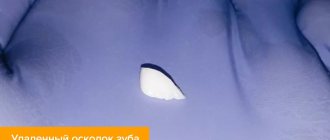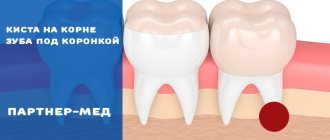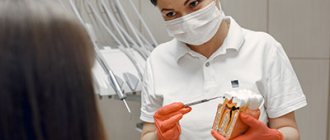For many people, rotten wisdom teeth pose a real and very serious threat to the health of the entire oral cavity - problematic third molars or, as they are also called, “eights” cause a lot of trouble for their owners. They erupt much later than the rest of the dentition (at about 20-25 years) and often become a problem already at the eruption stage.
What complications can wisdom teeth cause?
Difficulties arising from third molars are primarily associated with the late timing of their eruption and some anatomical features of the jaw structure:
- Lack of space for normal eruption. By the time the “eights” begin to cut, a person’s dentition is usually already fully formed, and there may simply not be enough space for the third molars. In addition, during evolution, the human jaw has decreased by about 1 cm, which also does not contribute to the normal growth of “eights”. In this case, tooth extraction is indicated to prevent displacement of the entire dentition.
- Incorrect position in a row (dystopia). Leads to soft tissue injuries, destruction and displacement of adjacent teeth.
- Incomplete eruption (retention). Impacted “eights” cause a lot of problems and discomfort - often such a wisdom tooth causes inflammation of the gums and diseases of the “neighbors” in the dentition.
- Pericoronitis. An inflammatory disease characterized by swelling of the gums near the wisdom tooth followed by suppuration. When teething is difficult, a so-called hood of mucous membrane is formed around the figure eight, which is the optimal place for the accumulation of food debris and the proliferation of bacteria. In this case, the wisdom tooth is cut and hurts due to inflammation of the hood. If nothing is done, gum inflammation develops not only next to the tooth, but throughout the entire jaw - this will require long-term and costly treatment of the gums.
- Deep caries of wisdom tooth. Third molars, as a rule, begin to deteriorate quickly, often at the eruption stage. Why do wisdom teeth crumble? This is due to both the peculiarities of its structure and its position: it is simply impossible to clean the “eights” well with paste and a brush, so food debris and bacteria necessarily accumulate there, creating favorable conditions for the development of infectious processes.
In all the described situations, it is better to remove wisdom teeth immediately, without waiting for serious complications to develop, and you will have to spend a lot of time and money on treating nearby teeth, as well as inflamed gums.
Symptoms of a tooth fracture
Injuries often go unnoticed, as a result of which the floor of a tooth that is deprived of sensitivity is broken. Also, the clinic may be absent if there is minor damage to the enamel. Such defects can only be determined visually during an independent examination of the oral cavity.
In other cases, when a tooth is fractured, a person experiences pain. A pain syndrome that limits the movement of the lower jaw occurs when a tooth breaks at the root, and the fragments injure the soft tissue of the gums. A tooth broken under the gum often causes loosening of adjacent units, bleeding and speech impairment.
Deputy Chief physician Sergey Evgenievich Brodsky
Sign up for a free consultation
+7
First aid for a fracture
When a tooth breaks and hurts, you should immediately seek help from a dentist. Before examination by a specialist, doctors at the Partner-Med clinic recommend providing first aid, namely:
- rinse your mouth with clean boiled water at room temperature or warm chamomile infusion;
- apply and firmly clamp the application with cotton wool or a bandage in case of bleeding;
- take a pain reliever with an anti-inflammatory effect (Analgin, Paracetamol, Ibuprofen) if there is severe pain;
- apply a cold compress to the sore spot;
- immobilize the jaw with a tight bandage if injury is suspected.
Complications
If the front upper or lower teeth are broken, this causes, first of all, aesthetic discomfort, as the smile changes, articulation and clarity of diction are impaired. It can often provoke the development of psychological problems and complexes. A broken chewing tooth disrupts the food processing process. Large particles of food entering the stomach lead to disruption of its functions. The development of pathological processes is accompanied by a feeling of discomfort in the abdominal area and heartburn. A broken tooth under the crown causes displacement of the prosthesis, deformation of adjacent units, or injury to the gums. There is also a danger of developing infectious and inflammatory processes as a result of the penetration of pathogenic flora into injured tooth and gum tissues.
Ask a question!
8
We'll call you back in 1 minute
Diagnostics
After visiting a dental clinic, a specialist relieves pain and conducts a visual examination of the oral cavity, during which it is possible to determine:
- degree of damage to hard dental tissues;
- dislocation of adjacent teeth;
- tissue necrosis;
- penetration of blood into the tooth cavity.
To obtain a complete clinical picture, assess the condition of the roots of a broken tooth, the degree of displacement and damage to the nerve fibers, an x-ray examination is performed. In case of severe injuries, an orthopantogram or electroodontometry is performed to determine the condition of the dental system and assess the viability of the pulp.
Can third molars be treated?
Wisdom teeth, like any other teeth, can be treated. But only if they erupt correctly, do not threaten the health and position of the rest of the dentition, and there is confidence that the treatment will be successful. If the specified conditions are met, it makes sense to preserve the “eight” for the following indications:
- If the sixth and seventh teeth are sick or severely damaged and must be removed, in this case the wisdom tooth is left as “the best of the worst” in order to provide the patient with at least some conditions for chewing, and the doctor - the basis for future prosthetics.
- If the six and seven have already been removed and it is necessary to preserve the abutment tooth for installation of prosthetic structures.
- In the presence of an antagonist tooth, completely healthy and subject to preservation.
In case of curved roots that complicate endodontic intervention, severe tissue destruction, dystopia or retention, no competent dentist will undertake to treat the “eights” - he will definitely recommend removal.
Symptoms
The patient cannot always see the preserved fragments and fragments of the tooth root. If they are severely damaged, they may be hidden by gum tissue. If the pathological process continues, symptoms occur:
- aching pain occurs in the area of a fallen or damaged tooth in the gum;
- when pressing on the problem area, sharp pain occurs;
- the gums swell, increase in volume, may turn red, and tissue may grow near the socket;
- bleeding appears at the site of the destroyed crown (spontaneous or due to mechanical impact);
- suppuration occurs and the temperature rises.
If any of these symptoms appear, you should immediately consult a dentist. They indicate a complicated inflammatory process. Without treatment, it can cause serious complications, including blood poisoning. Even if there are no symptoms described, tooth decay or collapse of the walls of the crown is a reason to urgently consult a doctor and undergo an x-ray.
Do you have questions about tooth extraction?
We will call you back within 30 seconds
+7
Why are wisdom teeth needed?
Why does our body need third molars at all? In fact, these are rudiments that not all people today erupt - approximately a third of the entire population of the planet does not even have the rudiments of third molars, although a few thousand years ago absolutely all adults grew wisdom teeth. They practically do not perform the chewing function, since the rest of the healthy teeth usually cope with it.
Today, “eights” are needed only as a “backup option” in case the first and second molars fall out or are severely damaged, and also as a factor preventing the loosening of neighboring teeth. They can also serve as a support for prosthetics - but, again, in all these cases we are talking about healthy and correctly erupted “eights”. In the same case, when a person has rotten wisdom teeth in his mouth, they will not be able to perform any of the indicated functions and it is better to remove them so as not to expose the rest of the dentition to the risk of infection.
Installing a crown on a chipped tooth
In case of significant injuries, if it is impossible to restore the crown part of the tooth, a new tooth can be obtained using prosthetics. The prosthesis - crown - is fixed on the root of the tooth if this part remains healthy and strong. Different types of crowns are used depending on the material of manufacture:
- Metal ceramics are the most inexpensive option. The design is durable due to the metal base, and aesthetic due to the ceramic layer. Such dentures become an ideal option for budget restoration of teeth in the chewing area. Installation of metal ceramics in the frontal area is possible, but the tooth will not look natural due to the lack of transparency.
- Zirconium dioxide is a modern high-tech material that has both the strength and aesthetics of natural teeth. Such crowns are made using computerized technology and are practically indistinguishable from natural teeth in appearance. They refract light correctly and have a certain degree of transparency, similar to tooth enamel.
- Ceramic crown. This option is only suitable for the front teeth, since the structure is not strong enough to withstand the full chewing load. Ceramics look very aesthetically pleasing.
Indications for removal
Healthy, well-positioned third molars with good oral access for possible treatment do not need to be extracted. There are clear indications for such an operation, and if they exist, it should be removed without waiting for complications:
- Deep caries of the wisdom tooth, as well as lack of normal access for full treatment.
- Chronic inflammatory processes caused by third molars, including in cases where the wisdom tooth caused inflammation of the gums.
- Chronic injuries to the oral mucosa due to incorrectly positioned “figure eight”.
- Impacted or dystopic teeth.
- The need for orthodontic treatment of bite defects if the doctor believes that the “eights” will prevent the dentition from occupying the correct position.
In all of these situations, it is recommended to remove the “eights” without delay.
Myth four: electric brushes and irrigators loosen fillings
Modern technologies have brought a lot of doubts and worries into human life. For example, people believe that active dental care using electric brushes and irrigators can ruin the situation with fillings.
“Here you need to know that a similar situation took place, but in a very short period of time. Then two factors coincided: the first composite materials with not the best physical and chemical properties were on the market, and ultrasonic toothbrushes had just appeared, which operated at a wave frequency at which really old fillings swayed,” says Ilya Antonov.
Manufacturers of brushes responded very quickly to this problem, changing the frequency of the oscillation wave to a more gentle one without losing the quality of cleaning, plus the properties of composites improved, and for a long time, for reasons related to the use of electric brushes and irrigators, fillings do not fly out, says the dentist.
Chew less often! Do I need to remove wisdom teeth and is fluoride toothpaste harmful? More details
Removal Features
As a rule, operations to remove third molars are always considered difficult, since these are the teeth that usually cause more problems. The operation can be simple, provided that the “figure eight” is located on the upper jaw and does not have pronounced developmental abnormalities. In all other cases (as well as in situations where the tooth is in the upper jaw, but has strong, curved and branched roots), the operation is considered complex and must be performed by a qualified dental surgeon.
Before performing an intervention, the doctor determines possible contraindications for a particular patient, examines an x-ray of the problem area and determines the optimal tactics for the operation. The duration of the procedure ranges from 1-10 minutes for simple removal and up to 20-120 minutes for complex removal, requiring a series of manipulations and suturing of the hole.
What types of chips are there?
If a wisdom tooth has chipped, the doctor must first determine the type of chip, as well as determine the extent and severity of the problem. All this is necessary to choose the optimal restoration method that can guarantee a long-lasting result. The types of chips are briefly described below:
- enamel - this may be a small chipped piece at the corner of the cutting edge, many patients do not notice such defects at first,
- dentin - a significant part of the crown is destroyed, as a result of which only one of its walls may remain. In this case, pain appears, the enamel becomes sensitive, especially to cold and hot,
- pulp injury – damage to the neurovascular bundle is especially dangerous, because it can lead to inflammation, the development of pulpitis and the need to remove the nerve.
After a visual examination, the doctor sends the patient for an x-ray. Already having a picture in hand, a specialist can make an accurate diagnosis and suggest optimal treatment tactics. If there are signs of enamel demineralization, a course of remineralization and fluoridation must be prescribed. In this case, the patient must undergo a comprehensive examination to find out the cause of the problem and eliminate it.
Removal of wisdom teeth under general anesthesia
Many patients are afraid to remove problematic “eights” because they fear that the process will be painful. However, you should not postpone the operation because of your own fear: modern methods of anesthesia allow the removal to be performed as painlessly and comfortably as possible for the patient.
Doctors usually recommend performing the intervention under local anesthesia, which will be sufficient to ensure the patient is comfortable during the operation. If for some reason a person is not satisfied with the methods of local anesthesia, there is always the possibility of having a wisdom tooth removed under anesthesia. It should be remembered that this option of pain relief is not available to everyone - there are certain contraindications:
- Decompensated diabetes mellitus and cardiovascular diseases.
- Post-infarction or post-stroke periods for up to 6 months.
- Acute inflammatory diseases of internal organs, including the respiratory system.
- Epilepsy.
- Severe thyroid disease.
- Bronchial asthma.
- Alcohol or drug intoxication.
The presence of at least one of the listed positions makes the removal of wisdom teeth under general anesthesia impossible. Before the operation, the patient must be examined to identify any contraindications to the use of anesthesia. In addition, you need to remember that certain preoperative preparation will be required, and the clinic itself, in which the wisdom tooth will be removed under anesthesia, must have all the necessary equipment, as well as a team of specialists who will treat and monitor the patient’s condition (anesthesiologists, resuscitators, trained nursing staff).
How to restore a broken tooth?
What to do if a tooth is broken in half vertically?
If the wall of a tooth is broken, the dentist tries to save one of the roots if there is a fracture of a molar that has several processes. To do this, root canal treatment is performed and removal of the appendage, which cannot be saved. Next, a crown is installed in place of the broken tooth wall.
What to do if a tooth is half broken?
If a tooth is broken in half and the chip is horizontal, the doctor evaluates the condition of the tooth and root system. A broken tooth can be repaired using composite resin for minor chips or removed for significant decay. After removing the unit, the dentist prescribes an implantation procedure with the installation of a pin.
What to do if a tooth breaks but the root remains?
If a tooth is broken and the root remains in the gum, based on x-ray data, a decision is made to preserve or remove the root.
When removing the root, the dentist offers two options for restoring the unit:
- dental implantation with the installation of a titanium pin;
- installation of adhesive bridges under a broken tooth with micro-locks on the back walls of supporting teeth.
If the size of the preserved stump is at least 3 mm, and the thickness of the remaining tooth walls is at least 1 mm, restoration is carried out using:
- filling and covering with a crown to restore the anatomical structure;
- restorations by implanting a fiberglass pin, filling and installing a crown;
- stump inlay covered with a crown.
What can you do if your front tooth is broken?
If the front tooth is broken in half, in the presence of a base, the doctor performs a build-up that will not only restore the functionality of the unit, but also restore the aesthetic appearance of the smile.
This restoration method is only possible when the broken front tooth is not affected by caries. In other cases, prosthetics are prescribed. Ask us your question DIRECTLY!
+7
DECIDE! They will definitely help you here!
What to do if your front tooth is broken at the root?
If a front tooth is broken at the root, the dentist always uses the most gentle techniques possible and tries to save the tooth if possible.
When is a tooth and root removed?
A broken wisdom tooth and a broken back tooth that is not involved in chewing processes are subject to removal. Doctors recommend removing a broken tooth if part of the hard tissue and root system is damaged, there are pronounced putrefactive processes and there is no possibility of restoring the tooth. The root subject to inflammatory and putrefactive processes, as well as the broken root of the front and chewing tooth, which cannot be restored, must be removed. The procedure is carried out using ultrasound after opening the gums. In difficult cases, the root is divided into several parts and then removed. After removing the broken tooth, a crown is installed.
Prevention
To prevent tooth fracture, specialists at the Partner-Med dental clinic recommend following the following prevention methods:
- undergo an annual dental examination;
- promptly treat caries and other dental diseases;
- Healthy food;
- replenish calcium deficiency with a course of vitamin-mineral complex;
- brush your teeth twice a day;
- After eating baked goods and sweets, rinse your mouth with clean water.
A broken tooth is a problem that anyone can face. Dentists at the Partner-Med clinic will help you choose the most gentle option for treating and restoring a broken tooth.
Request a call back or dial our number!
+7
This phone call does not obligate you to anything. Just give us a chance and we will help you!
Just pick up the phone and call us!
+7
We will definitely make you an offer that you cannot refuse!
Treatment or removal during pregnancy
In cases where a wisdom tooth is cut and hurts, causing constant discomfort to the pregnant woman, it can and should be treated regardless of the gestational age. If there is no acute pain and treatment can be postponed, then it is advisable to carry it out in the second trimester of pregnancy or after childbirth.
It is worth remembering that wisdom tooth removal, especially under anesthesia, is definitely contraindicated for pregnant women. Removing third molars is strongly not recommended due to the complexity of such an operation and the risk of developing postoperative complications. As for anesthesia, it cannot be used either for removal or for treatment - during pregnancy, only local anesthesia can be used, and the drugs should be selected very carefully and taking into account the patient’s condition.
Despite their name, wisdom teeth do not bring their owners increased intellectual abilities, but they can cause a number of very unpleasant problems with oral health. Typically, third molars “lead with them” swelling of the gums, purulent inflammation, the development of caries of neighboring teeth, as well as severe pain. Therefore, in modern dentistry they prefer to remove them, without waiting for serious complications to arise and longer and more expensive treatment to be required. In many European countries today, a common practice is to remove the “eights” immediately after their appearance, regardless of their condition and the correctness of eruption.
Prevention
To prevent chips on your teeth you should:
- Treat teeth affected by caries.
- Avoid putting unnecessary stress on your teeth.
- Monitor your general health.
- Correct malocclusion.
First aid at home for a chipped tooth:
- Apply a cold compress to the tooth.
- Rinse your mouth with clean water.
- For severe pain, take a painkiller tablet.
The chipped piece of the tooth must be preserved and shown to the dentist, who will be able to determine the degree of destruction from it and prescribe the appropriate treatment.
Myth six: after filling, do not eat for 2 hours
The recommendation to limit food intake after a filling procedure is still stable. Moreover, people often give it to themselves. “Before, the doctor put a filling and said that you need to not eat for 2 hours. Now this limitation is only due to the fact that we use anesthesia during treatment. After this, the patient does not feel part of his cheek and lip. By starting to chew in this state, the patient runs the risk of biting himself. That’s why I always say that you can eat as soon as the anesthesia wears off,” says Ilya Antonov.











